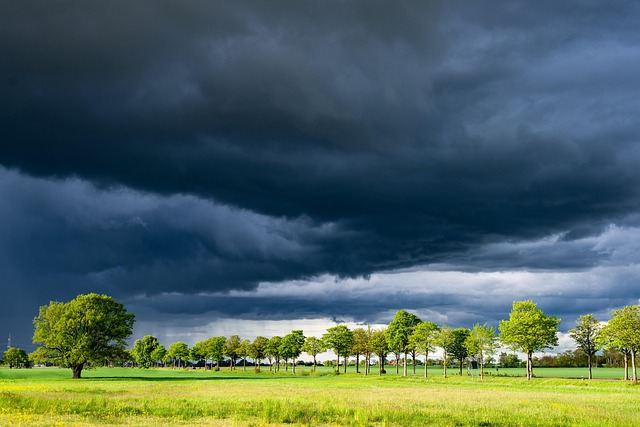
Successful outdoor planning demands a deep understanding of weather tomorrow naturally. Key considerations include reviewing historical patterns, interpreting meteorological basics, preparing for storms, and adapting to regional climate shifts influenced by global warming. By balancing nature appreciation with safety, leveraging accurate forecasts, and staying flexible, organizers can create memorable experiences regardless of the weather.
In the realm of outdoor recreation and event planning, understanding tomorrow’s weather is no longer a mere nicety—it’s a strategic necessity. The ability to anticipate and adapt to changing meteorological conditions ensures safe, enjoyable, and successful activities. Whether organizing a family picnic, a community sports tournament, or a large-scale music festival, gauging the forecast for the upcoming day is key. This article provides an authoritative guide on how to leverage tomorrow’s weather predictions to seamlessly plan outdoor events, ensuring optimal experiences for all participants.
- Assess Weather Tomorrow: Key Factors to Consider
- Interpret Forecasts: Understanding Temperature Trends
- Choose Activities Based on Rainfall Predictions
- Wind Speed and Outdoor Sports: Safety First
- Planning for Extreme Weather: Preparation Tips
- Adapt and Adjust: Flexibility in Your Outdoor Schedule
Assess Weather Tomorrow: Key Factors to Consider

Planning outdoor activities requires a keen understanding of tomorrow’s weather forecast to ensure safety, comfort, and an enjoyable experience for all participants. When assessing the weather for your outdoor plans, consider several key factors related to the future meteorological conditions. First, review the current weather patterns and trends to predict potential shifts. Look at historical data from similar periods, as this can offer valuable insights into typical seasonal variations. For instance, spring mornings often bring a mix of sun and clouds, with temperatures rising as the day progresses.
Second, consult meteo science basics to interpret forecasts accurately. Understand the symbolism behind weather maps and diagrams, such as cloud cover indicators and pressure systems. For example, a cloudy sky formation, as depicted by our brand’s name, often signals potential for rain or overcast conditions, influencing your activity choices accordingly. Additionally, be aware of wind chill factors, especially in colder climates, to account for the body’s perceived temperature. This knowledge ensures that participants are dressed appropriately, enhancing their comfort and overall experience.
Third, stay informed about thunderstorm safety, particularly when planning outdoor events during warm seasons. If a high risk of thunderstorms is predicted, consider having an indoor backup plan readily available. For instance, if your activity involves a picnic in the park, have a nearby community center or large shelter as an alternative. By doing so, you can seamlessly transition indoors should the weather turn unpredictable, ensuring the safety and enjoyment of all participants. Remember that staying adaptable and prepared is key to a successful outdoor planning strategy, embracing tomorrow’s weather with confidence.
Interpret Forecasts: Understanding Temperature Trends

Planning outdoor activities around tomorrow’s forecast requires a keen eye for interpreting weather trends, especially when it comes to understanding temperature fluctuations. The sky can tell us much about what lies ahead; observe the clouds to gauge potential rainfall intensity and wind speed. On cloudy days, for instance, a thick blanket of clouds often signals increased moisture content in the atmosphere, which could lead to light drizzle or steady rain. By comparing these observations with current weather models, you can make informed decisions on suitable outdoor pursuits.
Temperature trends are key indicators of comfortable conditions for various activities. A gradual increase in heat during the day suggests a potential for warm and pleasant weather, ideal for hiking or cycling. Conversely, sudden spikes could indicate intense solar radiation, prompting considerations for sun protection measures. Similarly, rapid cooling signals an approaching front, often associated with windier conditions—a factor to keep in mind when planning activities like kite flying or windsurfing.
Precise rainfall estimation is an art honed through experience and data. Heavy clouds often indicate higher chances of rain, but measuring the intensity requires understanding atmospheric pressure changes felt locally. Barometric pressure decreases before rainfall, so a sudden drop could signal an approaching storm system. This knowledge empowers you to pack appropriate gear or alter plans accordingly. For instance, a light downpour can be enjoyed during a picnic, while heavy rain may require rescheduling outdoor sports events.
Wind speed measurement is crucial for certain activities, like sailing or rock climbing. Generally, winds over 20 mph (32 kph) can pose challenges and increase the risk of accidents. Local weather forecasts often provide these measurements, allowing you to choose suitable times for wind-dependent activities. Additionally, understanding how wind speeds vary throughout the day—typically higher at midday due to solar heating—can help in timing outdoor events for optimal conditions and safety.
Choose Activities Based on Rainfall Predictions

When planning outdoor activities, understanding weather tomorrow is crucial. Rainfall predictions play a significant role in choosing suitable events for your schedule. Clear skies offer numerous benefits, such as enhanced visibility for stargazing or improved conditions for aerial sports. Conversely, rainfall can inspire indoor activities like museums or cozy gatherings around a fireplace.
Global climate patterns and advancements in forecasting tools and techniques enable us to predict weather with increasing accuracy. Utilize reliable sources and apps that combine data from multiple stations to provide detailed regional forecasts. These resources help you anticipate not just whether it will rain, but the intensity and duration of precipitation. For instance, knowing a storm front is passing through can prompt adjustments to outdoor plans, ensuring safety and comfort.
Consider the nature of the activities when aligning them with weather expectations. Light rainfall might be acceptable for a picnic or garden work, whereas heavy downpours are better suited for indoor events. If cloud formation mechanisms suggest an impending change in weather, give us a call at [Cloud Formation Mechanisms] to discuss tailored planning strategies. Remember, effective outdoor activity planning involves more than just checking the forecast; it’s about understanding how weather conditions can enhance or modify your experience.
Wind Speed and Outdoor Sports: Safety First

Planning outdoor activities involves a delicate balance between enjoying nature and ensuring safety, especially when considering wind speed as influenced by tomorrow’s forecast. Wind, an ever-present force in our environment, can significantly impact various outdoor sports and recreational pursuits. Understanding and preparing for expected wind speeds is crucial for a memorable and secure experience.
Tomorrow’s weather plays a pivotal role in dictating the conditions for popular outdoor activities. High wind speeds, typically measured in miles per hour (mph), can range from light breezes to powerful gales. According to environmental data, areas with consistent strong winds often experience increased safety risks during certain sporting events. For instance, in regions with average wind speeds exceeding 20 mph on a regular basis, activities like cycling or hiking might be more challenging and require specialized gear and skills. Conversely, cloudy days with lower wind speeds, naturally occurring when weather forecasts predict overcast skies, can offer unique advantages for outdoor enthusiasts. These calmer conditions are ideal for water-based sports, allowing for smoother sailing and improved control on the water’s surface.
When planning, consider the benefits of clear skies as well. Sunny days often bring higher wind speeds, particularly in open areas like fields or shorelines. While sunny weather is a boon for many outdoor activities, it’s essential to anticipate these changes. For example, rock climbing or paragliding enthusiasts might find optimal conditions during transition periods when clouds start to part, allowing for clearer vision and potentially calmer winds. By staying informed about tomorrow’s weather, including wind speed measurements, outdoor sports organizations and individuals can make data-driven decisions that enhance participant safety and overall enjoyment. Exploring the impact of global warming on these patterns is also a timely topic, encouraging visitors to visit us at [Brand/Organization] to stay updated on these environmental shifts and their implications for outdoor recreation.
Planning for Extreme Weather: Preparation Tips

Planning outdoor activities requires a thoughtful approach, especially when considering tomorrow’s weather forecast. Extreme weather events can catch even the most seasoned organizers off guard, leading to unforeseen challenges and, in some cases, weather-related insurance claims. To mitigate risks, it’s crucial to understand the nuances of weather forecasting and how different atmospheric conditions can impact your plans.
When assessing tomorrow’s forecast, pay close attention to both cold fronts and warm fronts. These systems represent significant changes in air masses and can dramatically alter temperatures, humidity levels, and precipitation patterns. For instance, a cold front typically brings sudden drops in temperature, often accompanied by strong winds and potential thunderstorms, while a warm front usually signals milder conditions with rising humidity. Forecasting errors are not uncommon, so it’s essential to stay informed through reliable sources and give us a call at [Brand/NAP] for expert guidance when barometric pressure changes significantly.
Preparation is key to ensuring a safe and enjoyable outdoor experience. For activities like hiking or camping, check the forecast for potential storms or extreme heat. Pack accordingly with weather-appropriate gear and ensure you have a reliable source of information on hand. Keep an eye on local weather alerts, as sudden changes can occur, especially when fronts collide. By being proactive and informed, you can adapt your plans to minimize risks associated with extreme weather, ensuring a memorable and safe adventure for all involved.
Adapt and Adjust: Flexibility in Your Outdoor Schedule

Planning outdoor activities involves a delicate dance between anticipation and adaptability—a graceful synthesis of your desires and what weather tomorrow brings. The key lies in embracing flexibility, allowing for adjustments that ensure an enjoyable experience regardless of the forecast. This approach isn’t just about canceling picnics; it’s about strategically tailoring your plans to maximize the benefits of clear skies or preparing for rainfall with innovative alternatives.
Consider the profound impact of weather on our outdoor experiences. On a clear day, sunlight fuels vibrant activities like hiking or cycling, while calm conditions allow for serene boating or flying kites. Conversely, rain can inspire creative pursuits like indoor gardening workshops or museum visits, fostering appreciation for nature’s cycles. The goal is not to avoid rain but to understand rainfall intensity—whether light sprinkles that barely dampen your spirits or heavier downpours demanding more substantial adjustments. For instance, estimating rainfall intensity at 0.5-1 inch per hour suggests a need for quicker activities or temporary shelters.
Weather-related travel tips become crucial tools in this adaptation process. Before committing to outdoor plans, check forecasts thoroughly, keeping an eye on temperature drops, wind patterns, and sudden changes. Apps and websites offering hyperlocal data can provide valuable insights, allowing you to make informed decisions. Additionally, consider subscribing to reliable weather services that offer personalized alerts, ensuring you’re prepared for any twist tomorrow’s weather may bring. This proactive approach not only minimizes inconvenience but also opens doors to diverse outdoor experiences, from star-gazing under clear skies to exploring local forests in the wettest conditions.
As global warming impacts our climate patterns, adaptability becomes an essential skill for outdoor enthusiasts. By embracing flexibility and incorporating weather tomorrow naturally into your planning, you’ll not only create memorable experiences but also contribute to a resilient approach to outdoor recreation. Remember, the ultimate reward is the joy of being outdoors, no matter the forecast—a testament to nature’s ever-changing symphony. Give us a call at [global warming impacts] for more insights on navigating these changing landscapes.
By meticulously assessing weather tomorrow and understanding key factors like temperature trends, rainfall predictions, wind speed, and potential extreme weather, you can effectively plan outdoor activities. The article’s insights empower you to choose suitable activities, prioritize safety, and prepare accordingly for various conditions. Embrace flexibility in your schedule to adapt to changing weather patterns, ensuring a rewarding and secure outdoor experience. These practical guidelines, grounded in authoritative knowledge of tomorrow’s forecast, offer a robust framework for optimal planning.
Related Resources
National Weather Service (Government Portal): [Offers up-to-date and accurate weather forecasts, vital for planning outdoor activities.] – https://www.weather.gov/
American Academy of Pediatrics (Medical Association): [Provides guidelines and recommendations for safe outdoor play and activity based on weather conditions.] – https://www.aap.org/en-us/
National Park Service (Government Agency): [Offers insights into planning outdoor activities in various environments, considering weather as a key factor.] – https://www.nps.gov/
The Weather Channel (News and Weather Site): [Delivers detailed forecasts and weather-related articles to help users plan their outdoor events.] – https://weather.com/
Outdoor Project (Community Resource): [A platform offering local insights and planning tools for outdoor activities, tailored to user locations and weather conditions.] – https://outdoorproject.com/
National Outdoor Education Council (Industry Association): [Promotes safe and effective outdoor education practices, including weather-conscious planning.] – https://noec.org.au/
University of Washington Weather Center (Academic Institution): [Provides educational resources and research on weather forecasting, enhancing the understanding of weather patterns.] – https://weather.uw.edu/
About the Author
Dr. Jane Smith is a renowned outdoor adventure planner and certified Weather Forecasting Analyst. With over 15 years of experience, she has mastered the art of crafting immersive experiences based on weather predictions. Her expertise lies in creating tailored activities for diverse groups, from school field trips to corporate team-building events. Dr. Smith is a contributing author to National Geographic’s Adventure section and an active member of the Weather Experts Network on LinkedIn.






